Different formats of Retailing
1) Department Stores
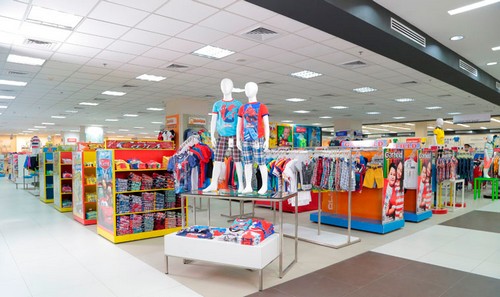
Department stores are large stores which sell different types of products under one roof in different departments. Each department has an individual specialization of merchandise. Each store is handled separately in accounting, management, and location.
Therefore, a department store handles different business units and deals with a variety of merchandise and are organized in different departments for the purpose of accounting control, sales promotion, and store operations.
The latest trend in department stores is to add departments for sports and recreational equipment and automotive along with providing services like travel advice, insurances, and income tax preparations, etc. Department stores can also be referred to as shopping centers.
Different classifications of department stores

Department stores can be classified on the basis of income groups or ownership.
- On the basis of ownership – There are three types of a department store on the basis of ownership
- The ownership Group – Ownership group stores are dependent formally but are combined.
- The independent – This type of department stores is owned by the financial interest which does not own any other similar stores.
Types of Department stores
- Chain Department Stores – This type of stores is owned and managed centrally.
- On the basis of income groups – These stores are designed to serve people with high- and middle-income groups. These stores sell high-quality goods and provide first class services to its customers. there are also stores which are designed to cater to people with low income such as dollar stores.
- Leased department stores – The stores whose operations are given out on lease are called leased department stores.
Various features of Department stores:
- Merchandises are arranged in different departments in the same store.
- Department stores are integrated stores which perform operations.
- department stores are distinguished by the nature of goods sold by them, not by the variety of goods sold by them like drug and variety store.
- Department stores are designed horizontally in order to provide different merchandises under the same roof.
Location of Department stores
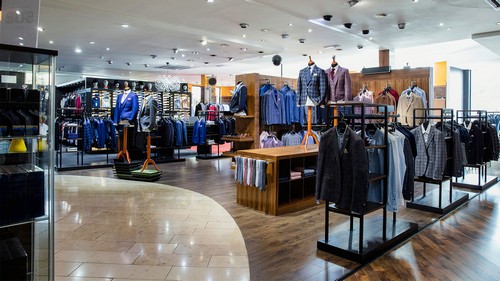
Special consideration should be taken into consideration before choosing the location of a department store. the store should not only provide merchandises only but it also should provide various amusement facilities, facilities in dine-in, and parking, etc.
Advantages of Department stores
- Department stores usually buy products in bulk which gets considerable discounts. in addition to this, department stores buy directly from the manufacturer therefore, it eliminates any middleman charges results in high profits.
- Department stores were a big business are in a position to pay for goods being purchased. In this way, quality goods can be purchased on much cheaper rates and also merchandise of the latest style and design can be obtained to be sold in stores.
- Department stores attract customers because of the convenience offered by them for people of all classes.
- Because of its large scale of business expert supervision can be provided for each department. In addition to this, various services like liberal credits, expert assistance for shopping, and delivery services can be provided to customers.
- Department stores can afford to spend on advertising to lure customers to buy more. For example, within department stores, various discount and offer advertisements are placed to make customers purchase more than they plan to buy.
Limitations of Department stores
- It is very expensive to run a department store as it includes various expenses. For example, a large number of salespersons are needed to handle different departments and cash counters.
- Because of its large size, personal touch and interaction with customers are missed. Which is not a problem in single line stores.
- As area required to establish these stores is large, they are usually set up on the outskirts of a city. Hence, these are not much beneficial for the customers as they have to buy urgently required goods from the nearby traders.
- As the whole control is in the hands of employees such as store managers there are high chances of leak and loss.
- Many times customers take advantage of “customers are always right” policy.
- it has been observed that in many stores poor salesperson service is provided because of the low payments given to them.
2) Super Markets
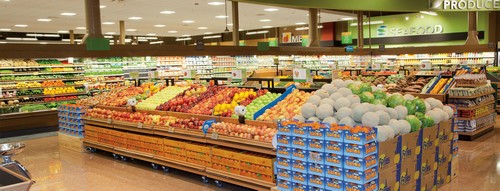
Supermarkets are self-service stores that sell a wide range of food as well as non-food products. supermarkets have at least four basic departments such as self-service grocery, dairy produce, meat, and household department.
These stores can be either entirely operated by owners or they are given on lease to others to operate.
Features of supermarkets
- Goods are displayed in bulk.
- Supermarkets are located in nearby housing areas so that people have easy access.
- These stores offer a wide range of products, low prices, nationally advertised brands, and also convenient parking.
- It follows the “cash and carry” policy.
- Minimum customers service is provided in these stores as these stores work on the basis of self- service.
Advantages of Supermarkets
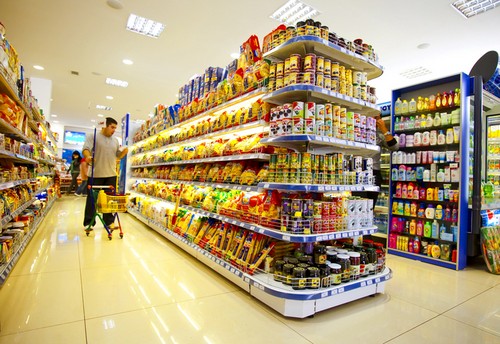
- The supermarket sells a wide variety of merchandises.
- The supermarket offers convenient shopping to customers as they can buy everything under one roof.
- supermarkets offer low-profit margins, high discounts, and convenience of buying everything under one roof.
- Customers don’t have to spend a lot of time.
Disadvantages of supermarkets
- Fewer customers services.
- Products which require instruction to use are difficult to purchase from supermarkets as there is no one to assist you.
- High administrative expenses required to run a supermarket.
3) Chain Stores or Multiple Shops
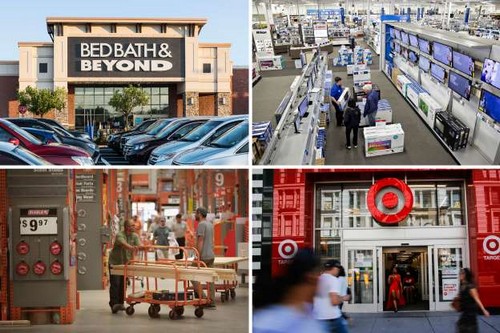
In this format of retailing, a chain store consists of four or more stores sell the same kind of merchandises and are owned and managed by a single owner. The supplies are stocked in chain stores are provided by one or more warehouses owned by the chain store owner.
This retail format is known as “Chain Stores” in America and known as “Multiple Shops” in Europe. In chain stores, customers are approached to provide them assistance and not forced to make purchases. More than one store can be opened in one city to magnet more and more customers.
The appropriate examples of chain stores are Wal-Mart, subway, Bed Bath and Beyond, and Body Shop, etc. Chain stores work on the basis of “Centralized buying with decentralized selling”.
Features of Chain stores
- When one or more shops are run under one name are called chain stores.
- There is centralized control over all the shops.
- Chain stores are integrated stores.
Advantages of Chain Stores:
- Chain stores offer low selling prices.
- Low advertisement cost as the advertisement is done on a central basis.
- Chain stores work on a cash basis. Therefore, there are fewer chances of bad debts and less accounting process required.
- No need to look for costly and centralized locations.
Disadvantages of Chain Stores:
- People believe that merchandises are sold at a low price which is clearly a false claim.
- Chain stores lack flexibility. As it does not offer wide varieties of products.
- There are high chances of a problem because there are several problems associated with the large scaled business.
- Chain stores do not provide facilities like Door delivery and credit facility. Therefore, it has a poor bad image.
4) Discount Houses
Discount house is a type of retail format which operates at low cost and almost no customer’s service. These stores are large in size, open for public and advertised heavily. They sell a wide range of products of well-known brands, housewares, appliances, sporting goods, house furnishing, toy and automotive services, and clothing, etc.
These stores operate on a self-service basis and no customer service is provided in them. Discount houses can be of different types such as small store, Full line limited service, catalogs type order offices. The stocks in discounts houses are bought from both wholesalers as well as manufacturers.
So far, you have learned about “In-store retail stores”. In the next section, you will learn about various types of “Non-store retail stores”. Almost 80% of transactions are made in stores. However, with the increase in the non-physical transaction the concept of non-store retail stores came into existence.
Hence, the rest 20% of trading transactions take place in non-store retail stores. There are five types of non-store retail trading formats such as telemarketing, direct selling, automatic vending, online retailing, and direct marketing.
5) Direct Selling
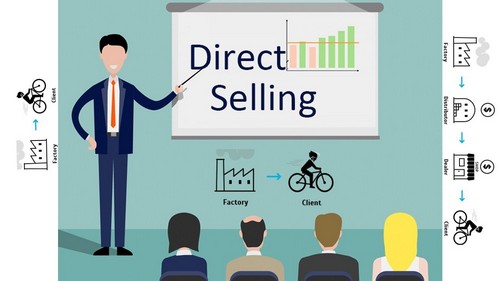
Direct selling is when customer and seller have direct contact with each other away from the store. direct selling is also referred to as home selling. The total volume of direct selling has been growing in India since the beginning of the 21st century.
Direct selling is not only popular in India but it is also utilized in many other countries. In Japan, approximately 35% of total selling is done by direct selling and in the United States of America, this number is 30%. There are two types of direct selling such as door to door and Party Plan.
There are a thousand big direct selling companies. Companies like Creative Memories, Amway, and Excel Communications are a few popular companies which make their business through direct selling.
These companies market various types of product through direct selling. Direct selling is the best-suited way to sell products which require extensive demonstration.
Features of direct selling:
- The whole business is controlled centrally.
- There is no building to display products.
- The seller needs to establish a relationship with the customers to gain their trust.
- Direct selling does not require heavy initial investments.
Advantages of direct selling:
- Customers can contact salesperson personally and can buy the product from the comfort of their home or at the non-store location.
- Customers can ask for a demonstration of how a product work before making investments to buy it.
- No expenses of maintaining or renting a building, stocking inventory, or hiring accountants and sales person to handle customers.
Disadvantages of Direct Selling:
- Even if there is a high sales commission on selling but this a salesperson will only get paid when he makes any sales.
- There are chances that your salesperson turns out to be fraudulent.
6) Telemarketing

Telemarketing is also known as telephone selling. In telemarketing, a salesperson initiates a sale over the phone to a prospect and close it over the phone only. It consists of cold canvassing from a phone directory. There are various products such as magazine subscriptions, pest control devices, club memberships, and credit cards which can be sold without seeing are usually sold over the phone. There are several problems associated with telemarketing also.
Telemarketing people sometimes encounter with hostile people on the telephone and receive many more rejections than close deals. Therefore, many sales person don’t last even for a week in this job and some telemarketers opt for unethical or questionable ways to somehow get a deal closed, for example, some firms call people at any time no matter day or night.
This method of selling is sometimes criticized for violating consumers’ right to privacy. Some states have put strict rules to limit the activities of telemarketers. Despite these limits, the sales over telephones have increased tremendously in the past few decades.
There are some people who like the convenience of shopping over the phone really appreciate telemarketing even though it is loathed by many people. The cost of selling through telephone has reduced drastically after the introduction of computers, as computers can dial automatically, deliver recorded messages, and even record information provided by the buyer.
The future of telemarketing clearly depends on the way the above-mentioned problems will be handled.
7) Online Retailing
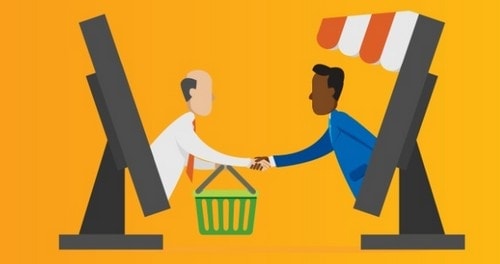
Online retailing is when a firm offers products on their website and people and organizations from this company. In this way, both entities engage in the online transaction also known as internet marketing or electronic transactions.
In online marketing, there are one or more businesses involved and the buyer is an ultimate consumer. The number of online retail firms are rapidly increasing such as Pets Mart, Busy.com, CDNow.com, Amazon.com, etc. Some online retailers launch general products form retailers such as Wal-Mart and Target.
On the other hand, there are some firms like “Amazon” which uses different methods broaden their business. it takes some investments to set up online operations. Online retailers use attractive advertising to attract shoppers and retain them. sometimes, online marketing proves to be expensive and unprofitable because of the offers and discount offered by online marketers.
Even with these challenges online marketing has a bright future and is expected to grow in the foreseeable future. according to a survey in 2005, people like to buy products like music, videos, books, apparel, computer hardware and software, and travel, etc. but at present time, many more categories such as toys, groceries, health aids, beauty products, pet supplies, and auto parts.
8) Automatic Vending

A sale is made without the slightest contact between a seller and a buyer through automatic vending. The idea behind selling through automatic vending is to provide convenient purchase. Products from well-known brands and those have great turn-over are usually sold through automatic vending machines.
Most of the selling from automatic vending comes from “4 Cs”: Coffee, Cold Drinks, Cigarettes, and candies. A vending machine is an appropriate way to expand business by reaching customers to such locations where there are no stores nearby or when they can’t come to a store.
The vending machines are installed in places like schools, colleges, workplaces, public facilities, etc. However, it is expensive to operate vending machines as they are required to replenish frequently.
In addition to replenishment cost, there are other costs of repairs and maintenance. The above-mentioned difficulties could be a reason for less scope of vending machines in the future. moreover, frequent vending-related scams scare entrepreneurs spending in this retail format. However, various innovations are made to make vending machine business more lucrative for customers such as purchase using debit cards.
The amount of purchase is deducted from the cardholder’s card. Technological advancement made it easy to monitor vending machines from distance and reducing the chances of out-of-stock, out-of-order, and theft incidences.
9) Direct Marketing

Direct marketing consists of all Non-store retail formats except telemarketing, direct selling, online retailing, and automatic vending. Direct marketing is a way of contacting customers through broadcasting or print media.
The products are advertised on these media and customers buy products online without even going to retail stores. The different platforms to contact customers through direct selling are Television, radio, magazines, newspapers, mailing, and catalogs, etc.
Direct marketing can be of two types such as general merchandise firms which offers various types of products and other is specialty firms which offers one of two lines of products for example Beauty and books.
This format of retailing includes
- Catalog Retaining – Catalogs are mailed to consumers or made provided to them in retail stores.
- Direct Mail – Samples products, brochures, and mail letters are sent to consumers and ask them to make a purchase through telephone or email.
- Tele-shopping – Various lines of products are sold on different television channels where people can learn about the features of the products and can place orders over the phone instantly.
Direct marketing also offers shopping convenience to consumers and it is also less expensive than owning a physical store as a seller don’t have to run store to sell. Often liberal return policies are given to consumers like the product without touching and seeing the product physically.
This can be a drawback for the seller as many people take advantage of this policy. Moreover, it is expensive to prepare catalogs and they are required to be prepared a long time ago before sending to the customers.
Therefore, additional supplement brochures or catalogues are required when new products are launched. The future of direct marketing is not sure on the basis of the present customer’s preferences.
10) Franchising
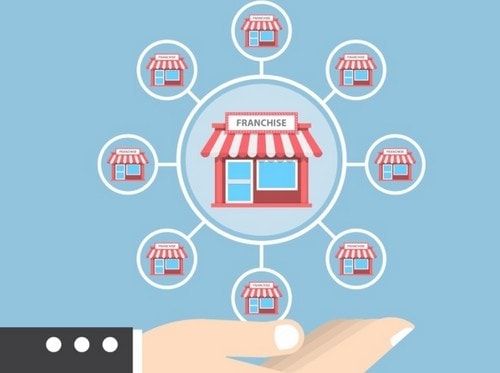
In this retail format, a businessman who owns the business (known as a franchise) and a company who offers business (known as franchiser). A businessman can use the name of already well-established business’s name to run their business under a certain condition set up franchiser.
The conditions vary from business to business however, a franchiser decides certain areas like site selection, location, training, management, marketing, financing, promotions, and record-keeping, etc. in addition to this, he also has rights to decide standard operating procedures and trade name of the business. A franchisee has to agree to follow conditions set by the franchiser.
Different benefits of franchising:
- Conserve capital.
- Low marketing costs.
- Easy to establish a distribution system to a short period of time.
- Cost of fixed expenses cut down substantially.
Franchising business exists for various products like automobiles and parts, soft drinks, dry cleaning, and business services, etc.
A Franchisee is required to do the following things before investing in any kind of franchising business.
Role of Franchise
- Do a reference check with a financial institution.
- Invest sufficient time and take measured risks.
- make enough enquires regarding the product such as its quality, exclusiveness, appeal, effectiveness, and competitiveness to get repeated business.
- Secure enough capital to buy a franchise because it is usually expensive.
- Bear in mind that you will be supervised and you will be required to take orders to run your business in a particular way.
- Take consultation from experienced for legal matters.
11) Mom and Pop stores
Mom and Pop stores are types of retail format which is a small, independent, family-owned business. This type of stores usually faces tough competition from big well-established businesses who can lure customers to buy more with their heavy advertising and marketing methods.
Mom and Pop stores can be different types of establishments such as bookstores, restaurants, insurance agencies, and automotive repair shops, etc. nowadays, mom and pop businesses have a high scope of success because more and more people demand personalized products and services.
In addition to this, with the invention of the internet, these small stores also take their business online and orders from customers irrespective of their geographical location.
Moreover, this type of stores is also supported by people of local communities as they want to invest their money in local businesses over foreign businesses.
12) Speciality Stores

Specialty stores are small in size and they generally offer limited products categories but provides a high level of service. The specialty stores can be a drug store, DIY stores, Category Killers, etc.
These were all the Formats of Retail stores or Retail Formats.
For details, visit
https://www.marketing91.com/formats-of-retailing/


No comments:
Post a Comment